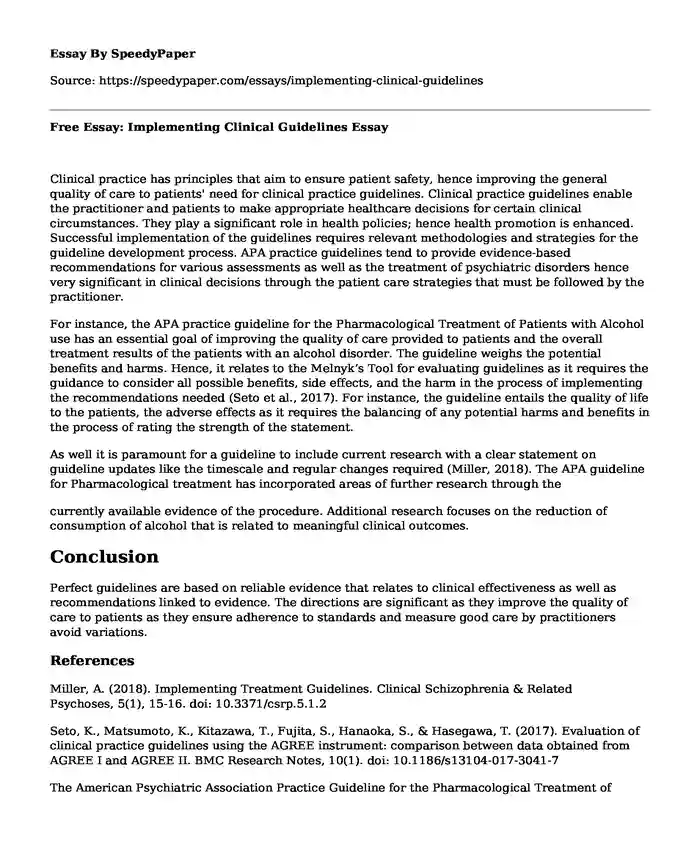
| Type of paper: | Essay |
| Categories: | Knowledge Medicine Public health |
| Pages: | 2 |
| Wordcount: | 429 words |
Clinical practice has principles that aim to ensure patient safety, hence improving the general quality of care to patients' need for clinical practice guidelines. Clinical practice guidelines enable the practitioner and patients to make appropriate healthcare decisions for certain clinical circumstances. They play a significant role in health policies; hence health promotion is enhanced. Successful implementation of the guidelines requires relevant methodologies and strategies for the guideline development process. APA practice guidelines tend to provide evidence-based recommendations for various assessments as well as the treatment of psychiatric disorders hence very significant in clinical decisions through the patient care strategies that must be followed by the practitioner.
For instance, the APA practice guideline for the Pharmacological Treatment of Patients with Alcohol use has an essential goal of improving the quality of care provided to patients and the overall treatment results of the patients with an alcohol disorder. The guideline weighs the potential benefits and harms. Hence, it relates to the Melnyk’s Tool for evaluating guidelines as it requires the guidance to consider all possible benefits, side effects, and the harm in the process of implementing the recommendations needed (Seto et al., 2017). For instance, the guideline entails the quality of life to the patients, the adverse effects as it requires the balancing of any potential harms and benefits in the process of rating the strength of the statement.
As well it is paramount for a guideline to include current research with a clear statement on guideline updates like the timescale and regular changes required (Miller, 2018). The APA guideline for Pharmacological treatment has incorporated areas of further research through the
currently available evidence of the procedure. Additional research focuses on the reduction of consumption of alcohol that is related to meaningful clinical outcomes.
Conclusion
Perfect guidelines are based on reliable evidence that relates to clinical effectiveness as well as recommendations linked to evidence. The directions are significant as they improve the quality of care to patients as they ensure adherence to standards and measure good care by practitioners avoid variations.
References
Miller, A. (2018). Implementing Treatment Guidelines. Clinical Schizophrenia & Related Psychoses, 5(1), 15-16. doi: 10.3371/csrp.5.1.2
Seto, K., Matsumoto, K., Kitazawa, T., Fujita, S., Hanaoka, S., & Hasegawa, T. (2017). Evaluation of clinical practice guidelines using the AGREE instrument: comparison between data obtained from AGREE I and AGREE II. BMC Research Notes, 10(1). doi: 10.1186/s13104-017-3041-7
The American Psychiatric Association Practice Guideline for the Pharmacological Treatment of Patients With Alcohol Use Disorder. (2018). doi: 10.1176/appi.books.9781615371969
Wilson, A. (2017). Book: Making Use of Guidelines in Clinical Practice; Implementing Clinical Guidelines: A Practical Guide. BMJ, 319(7216), 1078-1078. doi: 10.1136/bmj.319.7216.1078
Cite this page
Free Essay: Implementing Clinical Guidelines. (2023, Aug 31). Retrieved from https://speedypaper.net/essays/implementing-clinical-guidelines
Request Removal
If you are the original author of this essay and no longer wish to have it published on the SpeedyPaper website, please click below to request its removal:
- Free Essay on Medical Case Managment
- Essay Example - Application to the University of Wisconsin-Madison
- Does Plastic Surgery Enhance or Destroy Beauty, Essay Sample
- Free Essay: Non-Conventional Practices in Healthcare
- Free Essay Sample - Generalized Anxiety Disorder
- Nursing Course. Paper Example
- Paper Example. Modification and Accommodation for Learners With Inabilities
Popular categories




